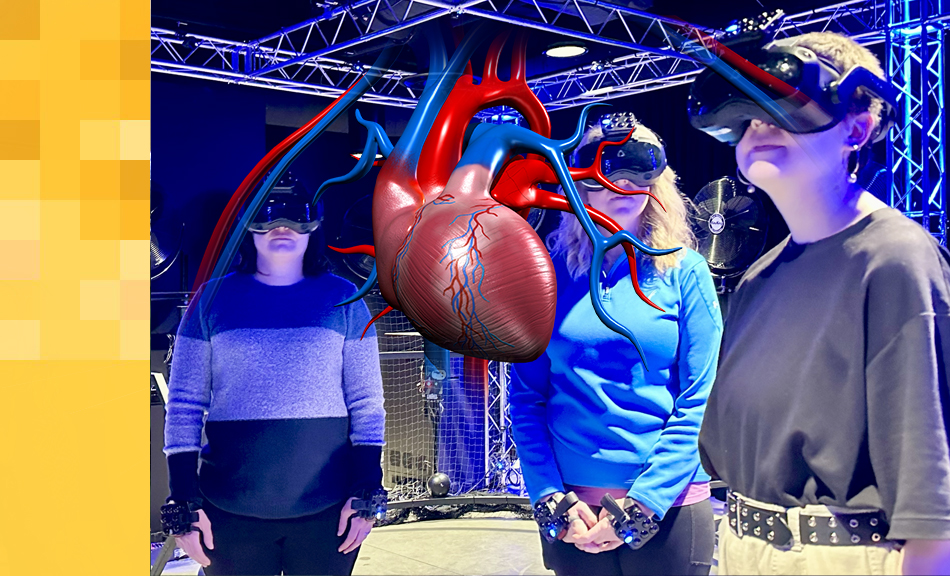Resources & Initiatives
Resources & Initiatives
Resources & Initiatives
Rowan’s Biomedical Visualization BFA students benefit from access to state-of-the-art facilities, cross-disciplinary collaborations, and nationally recognized initiatives that place them at the forefront of biomedical communication. Our resources span from traditional studio labs to immersive VR environments, giving students unparalleled opportunities to combine art, science, and technology.
Innovation Labs & Shared Resources
-
BMV Teaching Computer Lab (Westby Hall 216) – A dedicated studio equipped with high-end computers, professional illustration and design software (Adobe Creative Cloud, Autodesk 3ds Max & Maya, Substance, Unity, Unreal), and digital rendering tools.
-
VIVID Lab (Visualization, Immersive, Virtual, Interactive Design Lab) – Bozorth Hall 131 – A specialized research and creative lab where students explore interactive media, simulation design, and visualization projects.
-
MAVRC (Machine Learning, Artificial Intelligence & Virtual Reality Center) – Advanced immersive systems, including a 10-sided CAVE™ at the South Jersey Technology Park and a 4-sided CAVE™ at Rowan’s Camden Health Sciences Center, allow students to engage in AI-augmented, real-time VR experiences. MAVRC also provides GPU computing clusters for machine learning, rendering, and AI model training and visualization.
-
Dreamscape Learn at Rowan – A narrative-driven VR learning environment that transforms science and health education into cinematic, story-based experiences. Classrooms are equipped with motion capture, haptic feedback, and VR headsets, immersing students in interactive learning. Dreamscape Learn is housed in two locations: the Free Roam Pod at the South Jersey Technology Park and a 60-seat Immersive Classroom in the Campbell Library, at the heart of Rowan’s Glassboro campus.
-
Access to Science & Medical Resources – Students gain observational experience through courses and collaborations with Cooper Medical School, Rowan-Virtua School of Osteopathic Medicine, the Shreiber School of Veterinary Medicine, and regional institutions such as Philadelphia’s Mütter Museum, Franklin Institute, and the Academy of Natural Sciences.
Collaborations
Students and faculty collaborate across disciplines, engaging in real-world applied research with Rowan’s Colleges of Engineering, Science & Mathematics, Health Professions, Cooper Medical School, the Rowan-Virtua School of Osteopathic Medicine, the Rowan-Virtua School of Nursing & Health Professions, the Graduate School of Biomedical Sciences, and the Shreiber School of Veterinary Medicine. These partnerships give students opportunities to work on medical device visualization, VR simulations for healthcare training, and AI-driven biomedical research projects.
Initiatives & Grant-Supported Research
The BMAV program is deeply integrated into Rowan’s externally funded research culture. Faculty, including Professor Amanda S. Almon, MFA, CMI, have served as Co-Principal Investigator or Co-Investigator on more than $10 million in cumulative grants, with projects spanning:
-
Defense & Simulation – Turret Gunner Survivability & Simulation Environment (TGSSE), U.S. Department of Defense
-
Aviation Safety – Rotorcraft VR Visualization & Analysis, Federal Aviation Administration (FAA)
-
Healthcare & Medicine – Orthopedic VR Surgical Training (Camden Health Grant); ESMART end-of-life care decision support (NIH/NINR); Autism Spectrum Disorder Physician Training (Organization for Autism Research, NJDOH, NIH)
-
Education & Humanities – Teaching Holocaust History through VR/AR; New Projects in the Red Bank History and immersiove historical reconstructions using Dreamscape Learn.
These initiatives provide BMAV students with hands-on opportunities to contribute to applied research in biomedical communication, VR simulation, UX/UI design, and generative AI workflows.
Support & Professional Development
-
Software & Learning Resources – Students have access to Adobe Creative Cloud, Autodesk, Unity, Unreal, Substance, LinkedIn Learning, and remote computing via Citrix.
-
Mentorship & Peer Learning – Faculty mentorship, peer collaboration, and interdisciplinary teamwork prepare students for professional practice.
-
Professional Pathways – Students are guided toward membership in the Association of Medical Illustrators (AMI) and the Guild of Natural Science Illustrators (GNSI), including preparation for the Certified Medical Illustrator (CMI) credential.
Rowan’s Biomedical Visualization BFA provides an ecosystem where students can create, research, and innovate—benefiting from access to labs, faculty-led grant projects, and immersive technologies that set the program apart nationally.
